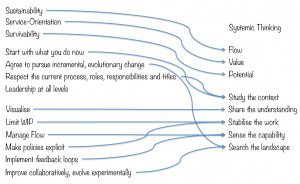When I first coined the term Kanban Thinking for the model of how I approach working with teams and organisations, I described how I wanted to encourage more definitions of kanban to lead to less dogma about what it is or isn’t. That’s still the case, but there is always the risk that multiple definitions leads to competition and a scarcity mindset. One of my favourite mantras is “feed the soil, not the plants”, and I prefer a mindset of abundance, so in this post I want to map Kanban Thinking to the Kanban Method, with a goal of showing the relationship between the two, and how they are complementary rather than alternatives.
Here’s a recap of the elements of Kanban Thinking:
- Systemic Thinking
- Impacts
- Flow
- Value
- Potential
- Interventions
- Study the Context
- Share the Understanding
- Stabilise the Work
- Sense the Capability
- Search the Landscape
(Eagle-eyed readers might notice that I have updated some of the language again – I need to blog about this soon!)
How do the elements of the Kanban Method relate to this? Note that this is a very simplistic mapping – there are richer nuances which would come across is a deeper comparison. I have included the recent Kanban agendas as part of the Kanban Method.
Agendas
The agendas relate primarily to the Kanban Thinking Impacts:
Sustainability primarily relates to Flow, in that an efficient and reliable process reduces the burden on people. Equally, it can also relate to Potential for the same reasons as Survivability (see below).
Service-Orientation relates to Value, in that an effective and valid product is the result of providing a good service.
Survivability relates to Potential in that an organisation with euphoric people who can be adaptable is more likely to have a longer lifespan.
Principles
Start with what you do now relates to Study the Context in order to get knowledge about where you are starting.
Agree to pursue incremental, evolutionary change relates Search the Landscape by running small, recoverable experiments on potential improvements.
Respect the current process, roles, responsibilities and titles also relates to Study the Context to understand all those aspects of the initial starting point.
Leadership at all levels has no direct relationship to Kanban Thinking. Tenuously it could relate to an impact on Potential in that having leadership at all levels should lead to greater future sucess.
Practices
Visualise relates to Share the Understanding which is the underlying intent of visualisation.
Limit WIP relates to Stabilise the Work by containing the amount of work in the system to balance demand with capability.
Manage Flow relates to Sense the Capability in terms of flow, and therefore also making an impact on Flow.
Make policies explicit also relates Stabilise the Work by creating clear standards of quality as a baseline for improvement.
Implement feedback loops relates to Sense the Capability by creating the mechanism through which performance can be understood.
Improve collaboratively, evolve experimentally (using models & the scientific method) relates to Search the Landscape by running small, recoverable experiments on potential improvements.
What does this tell us?
The key take away should be that there is a close mapping between the two and, and while there are some slight differences in emphasis, they are extremely compatible as mutual approaches. There is certainly no competition or need to choose one over the other! While we could start getting into some form of SWOT analysis of each, I’m not sure that would be worth the effort.
However, it is worth understanding how can they can be distinguished in a way that highlights how they are different and yet complementary. One of the things that is motivating this for me is to be able to put together a “Kanban Thinking” course/offering which would be appealing to anyone who’s been on an LKU approved Kanban Method training.
This is what I’ve come up with:
- The Kanban Method is an approach to delivering service-oriented knowledge work in a sustainable and survivable way.
- Kanban Thinking is a model with which to design and evolve a system which can implement the Kanban Method.
So in summary:
- Kanban Thinking is a model which can be used implement the Kanban Method.
- Equally, the Kanban Method can be implemented without using Kanban Thinking.
- And Kanban Thinking can be used to create a kanban system without using the Kanban Method.


[…] Kanban Thinking and the Kanban Method (Karl Scotland) […]
[…] Kanban Thinking and the Kanban Method […]
[…] Kanban Thinking and the Kanban Method (Karl Scotland) […]